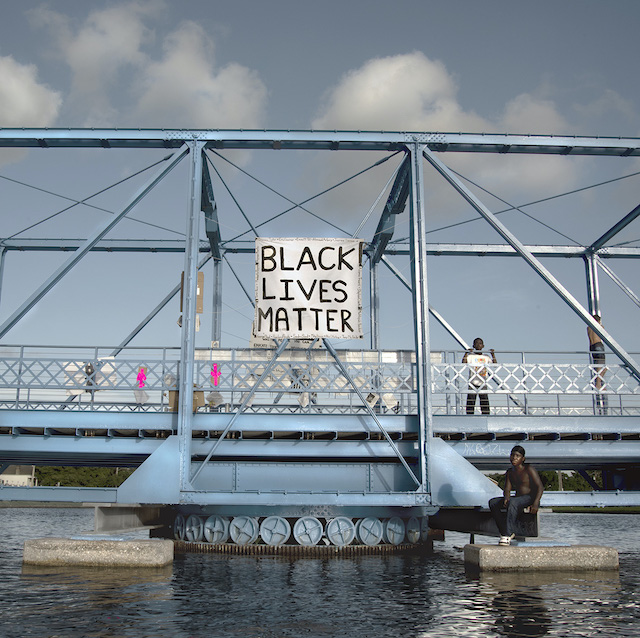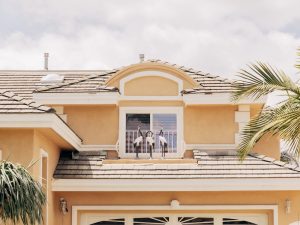Virginia Hanusik captures the perilous nature of New Orleans, one of the rainiest cities in America

There’s something spellbindingly confrontational about Virginia Hanusik’s All The Good Earth. In one image, there’s an electricity pylon standing solo between the rose-tinted sky and water. Its placement is off and illusory. Another sees a house on stilts, built metres above the ground in preparation for its next downpour. Although not your typical display of climate change, each violet picture and soft composition has a vital story to tell; it represents the perilous nature of New Orleans, one of the rainiest cities in America.
New Orleans is located just 14-feet above sea level and sits adjacent to the Mississippi river. Because of its precarious placement, the city has been prone to flooding and frequent downpours since its founding in the early 18th century. Some falls could last weeks, with deluges so deep that its inhabitants would have to wade through the streets in rowing boats. Coupled with unsanitary conditions, poor sewage collections and disposal systems, the area would often experience more than just flooding; it was also victim of fires and diseases. Then as the years went by, New Orleans developed the necessary maintenance and heavy infrastructure to keep its disasters at bay – a solution for now, that is.

Virginia grew up in upstate New York and moved to New Orleans in 2014, working at a non-profit company involved in Louisiana’s coastal restoration efforts. With a background in academia, architectural history and urban planning, the subject of Louisiana and its relationship with the environment has consistently propped up as her muse. “Prior to moving to Louisiana,” she says, “climate change was largely an abstract issue to me, but one I was committed to understanding the root causes of, such as why certain communities were more vulnerable to the impacts of the climate crisis over others. I began photographing as a way to understand the changes in the landscape that I was working in daily.”
Louisiana is currently in the process of erosion. With the steady depletion of marshes, swamps and barrier islands along the coast, the lands are resultantly more vulnerable to hurricanes and storms, particularly within New Orleans and localities in the region. Photography is an apt tool for raising awareness of these issues, yet more often than not, the media will portray the narratives in stereotypically negative fashion. “Especially along the Gulf Cost,” adds Virginia. “I saw a lot of climate change photography focused on destruction. I became interested in exploring other ways to communicate these layered and complex transformations that were happening.”
This is why Virginia’s All The Good Earth – and many of her works preceding – has a luminous warmth about it. The imagery disdains from the typical offering of harsh and destructed lands, and instead offers up an alternative depiction of a city in constant transition. “Living in New Orleans for the greater part of the last 10 years has made me acutely aware of the role water plays in shaping the city’s geography and culture,” she says, signalling to the colossal human engineering that’s been maintained in the city. “It begs the question of how sustainable our current system of operating really is. Hard infrastructure – canals, levees and drainage pumps – are all around us making life possible here, and we’ve normalised these massive alterations to natural systems.”

Virginia dissects these themes with credulity, where the specific light of Louisiana – which she calls “extremely special” – brightens the issues at hand with a certain radiance, a tone that gives Joshua Tree’s infamous dusky beams a run for its money. “I’ve tried to make photographs feel like you’re situated in the glow that is felt here during the golden hour and sunsets, where the light wraps all around you, especially if you’re near the lakefront.” In doing so, Virginia completely twists the common associations with climate change photography and ends up painting her own language. “It’s more interesting for me to figure out different ways of photographing these structures, those that have historically been captured in a very straightforward, banal way.”
It’s not a new technique, to take a deep and harsh topic and turn it into a whimsical display of light and colour. But to do so with the topic of New Orleans and its troubles with water, gives Virginia’s work an indispensable and crucial stance in the field; it draws you in, entices you and hopefully inspires you to do something about it. “I hope that the work encourages people to learn more about the history of South Louisiana, and that they recognise its place in the canon of American landscape art,” she says. “The visual narrative around climate change is diversifying, which is greatly needed. So I hope projects like mine can lead to a larger discourse around how we design and inhabit space.”
Photography by Virginia Hanusik











